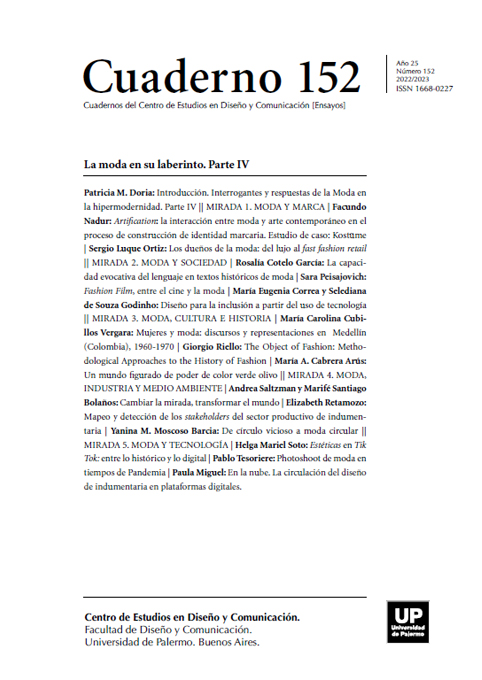Un mundo figurado de poder de color verde olivo
Abstract
The presentation analyzes the role of fashion in the construction of the revolutionary image of Fidel Castro, evaluating its political impact. It is argued that the olive green campaign uniform contributed to establishing the political vanguard role of the guerrilla led by Fidel Castro and presenting him as the leader of the revolutionary movement, making agents such as the urban underground resistance, traditional political parties and the communist party invisible. . Likewise, the guerrilla style of Fidel Castro and the other revolutionary leaders is presented as the place of enunciation of a new political allegory, that of the revolutionary, who would embody the image of Fidel Castro and, after the assassination of Che Guevara in 1967, that of this of last month. It also analyzes the efforts of the revolutionary leadership to extend the use of the olive green uniform to the citizens, through mass organizations of a military and paramilitary nature that advocated the ideal of a revolutionary New Man formed in the image and likeness of Fidel Castro. All of this would form a figurative world of power that would present post-revolutionary Cuba as a society in revolution, and would legitimize the leadership of Fidel Castro, with echoes that reach the contemporary world of international fashion and politics.
References
Afanasiev, V. (2002). Fuerzas armadas y política revolucionaria: el caso de Cuba de 1959 a los años 90. Santo Domingo: CLACSO.
Beath, M. C. (1961). Limpia en el Escambray, Verde Olivo. 54. Los alfabetizadores que permanecieron en las ciudades no recibieron uniforme. Florida: Universidad de Florida.
Cabrera Arús, M. A. y Suquet, M. (2019). La moda en la literatura cubana, 1960 - 1970: tejiendo y destejiendo al hombre nuevo. Nueva York: World Publishing.
Cabrera Arús, M. A. (2019). Fashioning and Contesting the Olive-Green Imaginary in Cuban Visual Arts., eA Movable Nation: Cuban Art and Cultural Identity. Gainesville: University Press of Florida.
Campos Menéndez, R. F. (1983). 35 preguntas sobre la SEPMI. La Habana: Editora Política.
Che Guevara, E. (1967). Man and Socialism in Cuba. La Habana: Guairas.
Clayfield, A. (2019). The Guerrilla Legacy of the Cuban Revolution. Gainesville: University of Florida Press.
Coyula, M. (2007). El Trinquenio Amargo y la ciudad distópica: autopsia de una utopía. La Ventana. Disponible en: http://laventana.casa.cult.cu/modules.php?name=News&file=article&sid=3666.
Díaz Infante, D. (2014). La revolución congelada. Dialécticas del castrismo. Madrid: Verbum.
Fernández, A. (1998). Castro’s Daughter: An Exile’s Memoir of Cuba, translated by Dolores M. Koch. Nueva York: St. Martin’s Press.
Fernández Cañizares, O. (2010). Primer viaje del Che al exterior. Aniversario 50. La Habana: Ciencias Sociales.
Fernández, D. (1993). Youth in Cuba: Resistance and Accommodation, in Conflict and Change in Cuba. Albuquerque: University of New Mexico Press
Ferrer, C. (1987). El movimiento pioneril en Cuba, en Apuntes para la historia del movimiento juvenil comunista y pioneril cubano. La Habana: Editora Política.
Glinn, B. (2015). Cuba 1959. Londres: Rare Art Press
Guevara, E. (1961). Guerrilla Warfare. Nueva York: Monthly Review Press.
Hugh, T. (1971). Cuba: The Pursuit of Freedom. Nueva York: Harper & Row.
Lockwood, L. (2016). Castro’s Cuba: An American Journalist’s Inside Look at Cuba (1959– 1969). Berlín: Taschen.
Luke, A. (2018). Youth and the Cuban Revolution: Youth Culture and Politics in 1960s Cuba. Lanham, MD: Lexington Books.
Martínez Heredia, F. (2018). La fuerza del pueblo. Pensar en tiempo de Revolución. Buenos Aires: CLACSO.
Montalván Lamas, O. (2011). Un trascendente hecho de cultura: La Campaña de Alfabetización. La Habana: Debates Americanos.
Pérez, A. (1987). La Unión de Jóvenes Comunistas. La Habana: Editora Política.
Pogolotti, G. (2014). La cultura del vestir. Cuba: La Jiribilla.
Rivero, Y. (2015). Broadcasting Modernity: Cuban Commercial Television 1950-1960. Durham, NC: Duke University Press
San Martin, M. y Bonachea, R. L. (1970). Guerrillas at War. New Brunswick, NJ: Transaction Sartre, J. P. (1960). Sartre visita Cuba. La Habana: Ediciones R.
Sejourné, L. y Coll, T. (1980). La mujer cubana en el quehacer de la historia. Ciudad de México: Siglo Veintiuno.
Sierra Madero, A. (2020). Reinaldo Escobar: ‘Mi norma personal es ajustarme a la verdad. Disponible en: https://www.hypermediamagazine.com/columnistas/fiebre-de-archivo/reinaldo-escobar-mi-norma-personal-es-ajustarme-a-la-verdad/.
William, M., Grande, L. y Kornbluh, P. (2015). Back Channel to Cuba: The Hidden History of Negotiations between Washington and Havana. Chapel Hill: University of North Carolina Press.
Los autores/as que publiquen en esta revista ceden los derechos de autor y de publicación a "Cuadernos del Centro de Estudios de Diseño y Comunicación", Aceptando el registro de su trabajo bajo una licencia de atribución de Creative Commons, que permite a terceros utilizar lo publicado siempre que de el crédito pertinente a los autores y a esta revista.


